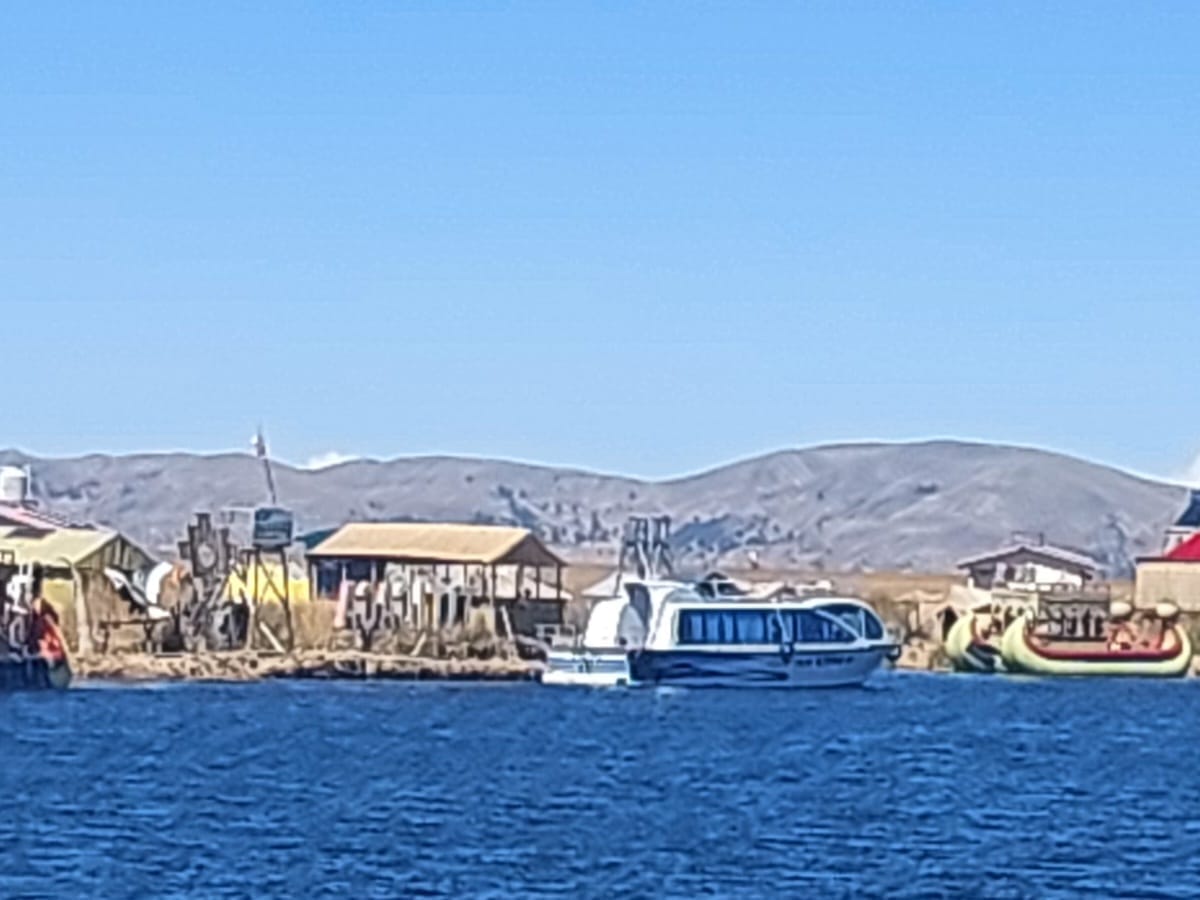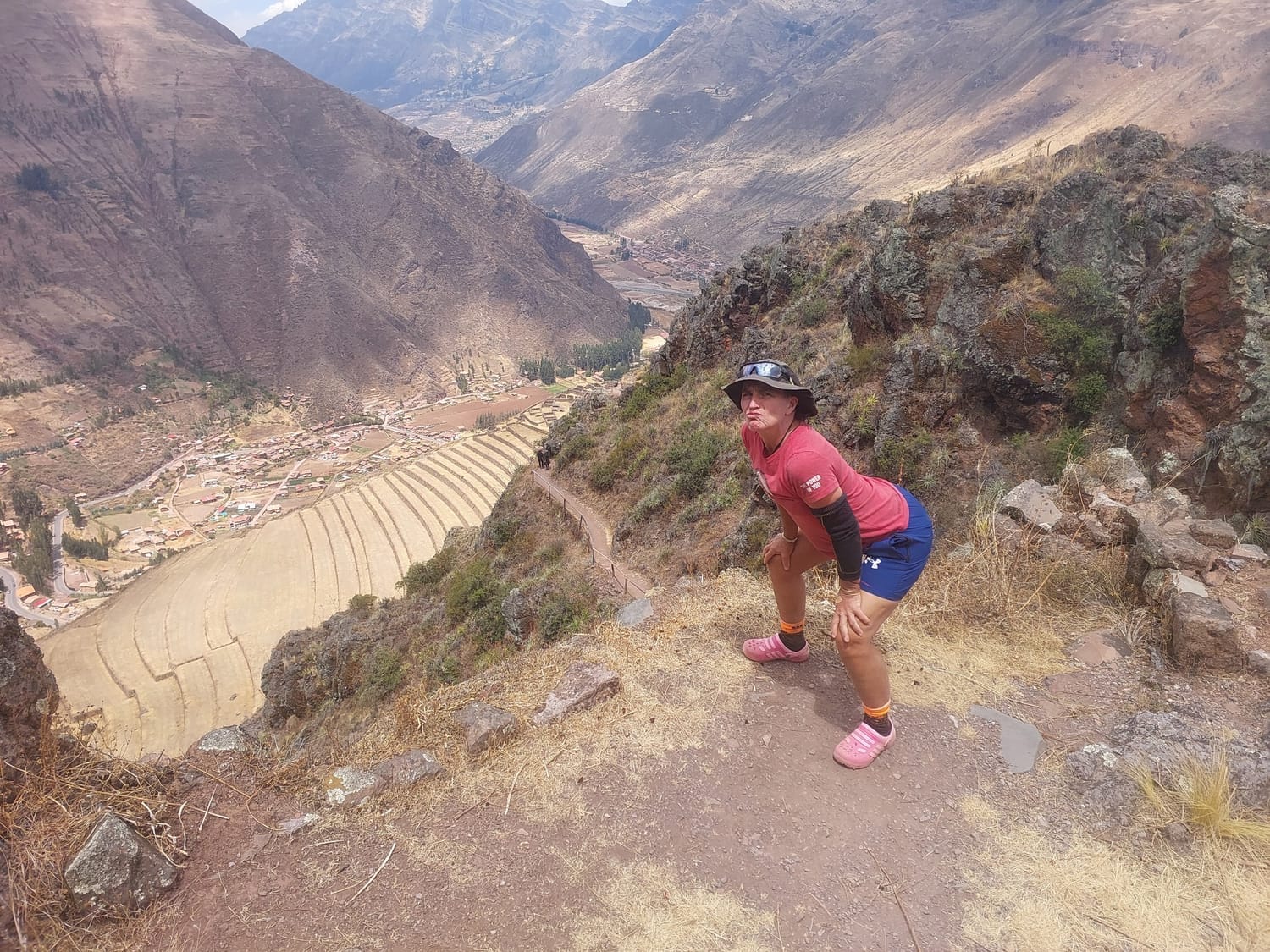Colitas Con Canas to Juliaca
We leave our furry friends to continue south. On our bikes again we felt the freedom of the wind in our faces, hills that tested our sanity and food that was pure happiness.
Colitas Con Canas to Pisac
We kicked off the morning with lumps in our throats. Serving brekkie to our furry mates one last time wasn’t easy. Two weeks ago most of these dogs were wary, holding back. Now they swamp us with love in their own ways.
Gloria, who once wouldn’t come near a human, now sidles close enough to sniff my hand.
Grampy old Sancho, three legs and all, will plonk himself down beside me in the sun.
Ollie, who growled and even gave me a cheeky nip at the start, now leans in with his eyes closed while I pat him.
And wee Twerty , I call her Patch for her single eye, just sits patiently outside the volunteer room door every morning. She never jumps or demands, just quietly keeps me company.
I could go on about every one of them, but today…it’s time to ride.
Colitas Con Canas has been more than just a shelter. It’s been a lesson in patience, teamwork, and respect, human and canine. Leaving feels heavy, but we roll out as better people, and with friends for life.
The road today was what we now call flat, we were starting 1500m of climbing in 250km. After Ecuador and northern Peru’s endless 1000m grinds, daily, this feels like riding downhill.
We stopped in Lamay for lunch and stumbled into a full-blown local ceremony, masked dancers, drums, colour everywhere. We tucked into pollo con papas while soaking it all in.
Then we finally met the “cool guys.” We’d first spotted them weeks ago, on the drive from Cusco to Urubamba. L
amay is guinea pig central, and the main road is lined with giant Guy statues — Guy the Chef, Guy the Local, Guy the King, Guy the Artist, and Guy the Butler.
Of course, we stopped at every single one for photos.
By mid-arvo we rolled into Pisac and found a hostel on the edge of town, perfectly placed for tomorrow’s Inca finale. Rustic? Yep. Cheap? Yep. Safe? …not so much.
The volunteer showed us to our room and a spot to stash our bikes. Job done, we thought.
Except not. The owner turned up later and lost the plot over where our bikes were stored. Aggressive, rude, and zero interest in the fact that these bikes are literally our lives.
After a heated back-and-forth, he grudgingly gave us another spot. Maree and I looked at each other and agreed: one night only, then we’re out.
But the story wasn’t done. When we went to pay, it all kicked off again. I told him straight he shouldn’t talk to customers like that, and that was it, game over. He completely exploded.
Minutes later his partner, clearly terrified of him, came to our room shaking and told us we had to leave. Money back in hand, bags on, out the door.
Weirdest. Experience. In. Peru.
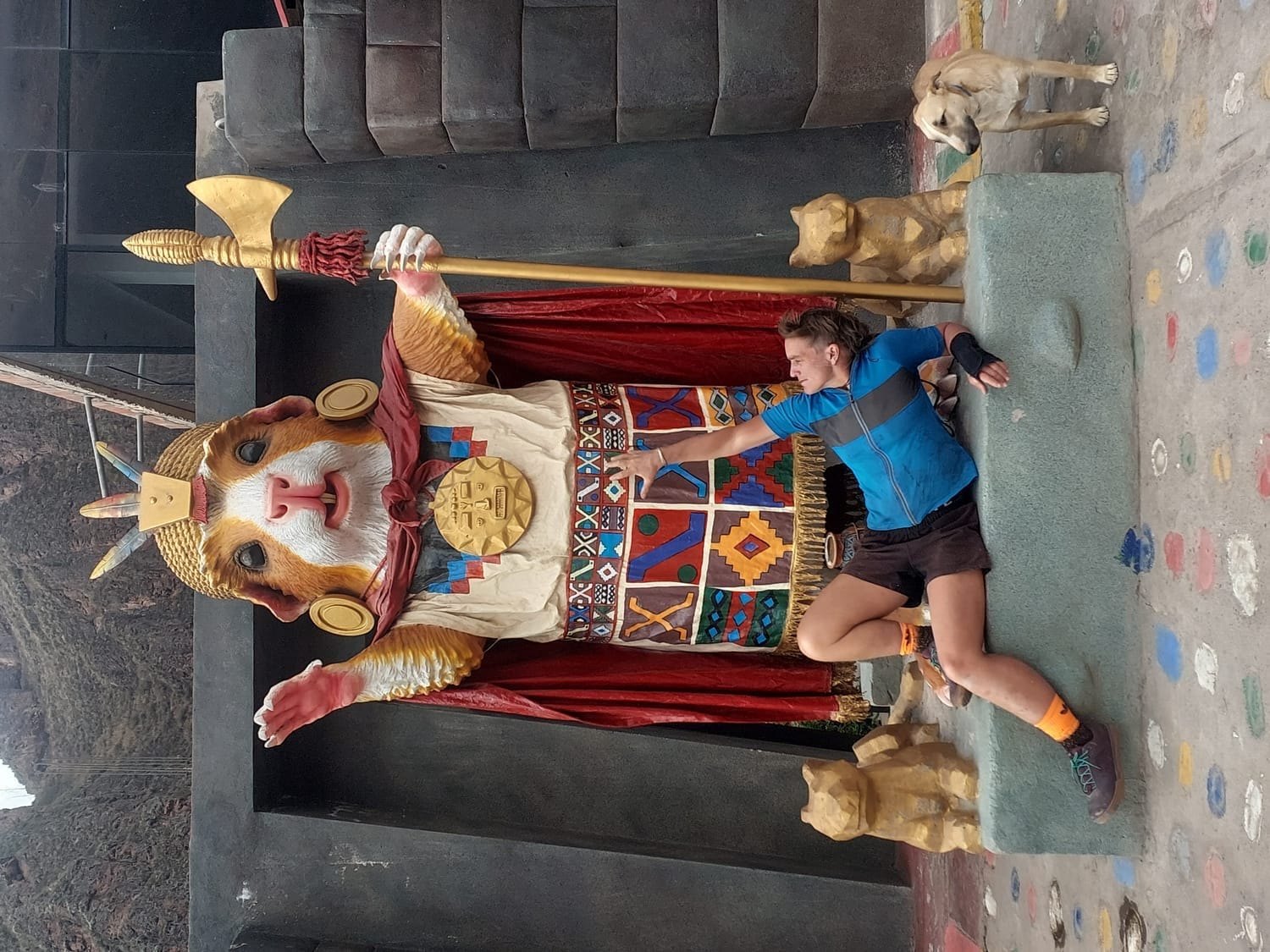
Pisac -Exploring
Emily told us not to miss the Pisac ruins, so up the hill we went....taxi style. We landed smack in the middle of tourist-van chaos, the carpark bursting with matching hats, selfie sticks, and guides waving flags like airport ground staff.
The main site was jaw-dropping though. Terraces ran down the slopes like giant green staircases, the Inca’s version of Countdown carparks, only a thousand times more stunning.
Above them, a stone village clung to the ridge, proof these people weren’t just good builders, they were next-level.
But the real magic came when we ditched the crowds and followed Emily’s sneaky route down the mountain. Suddenly it was just us, the wind, and more ruins tucked into the hillsides.
One site felt like a gathering place—stages, stone walls, little rooms carved out for living. You could almost picture the community vibe. No slavery, no money, no hoarding of gold, just everyone pitching in, working the terraces, and living off what they grew. Imagine that.
By the time we wound down the zig-zag track, it spat us out bang in the middle of Pisac’s town square. After all that high-minded Inca admiration, we balanced the scales with empanadas and ice cream. Because let’s be honest—food is our religion.
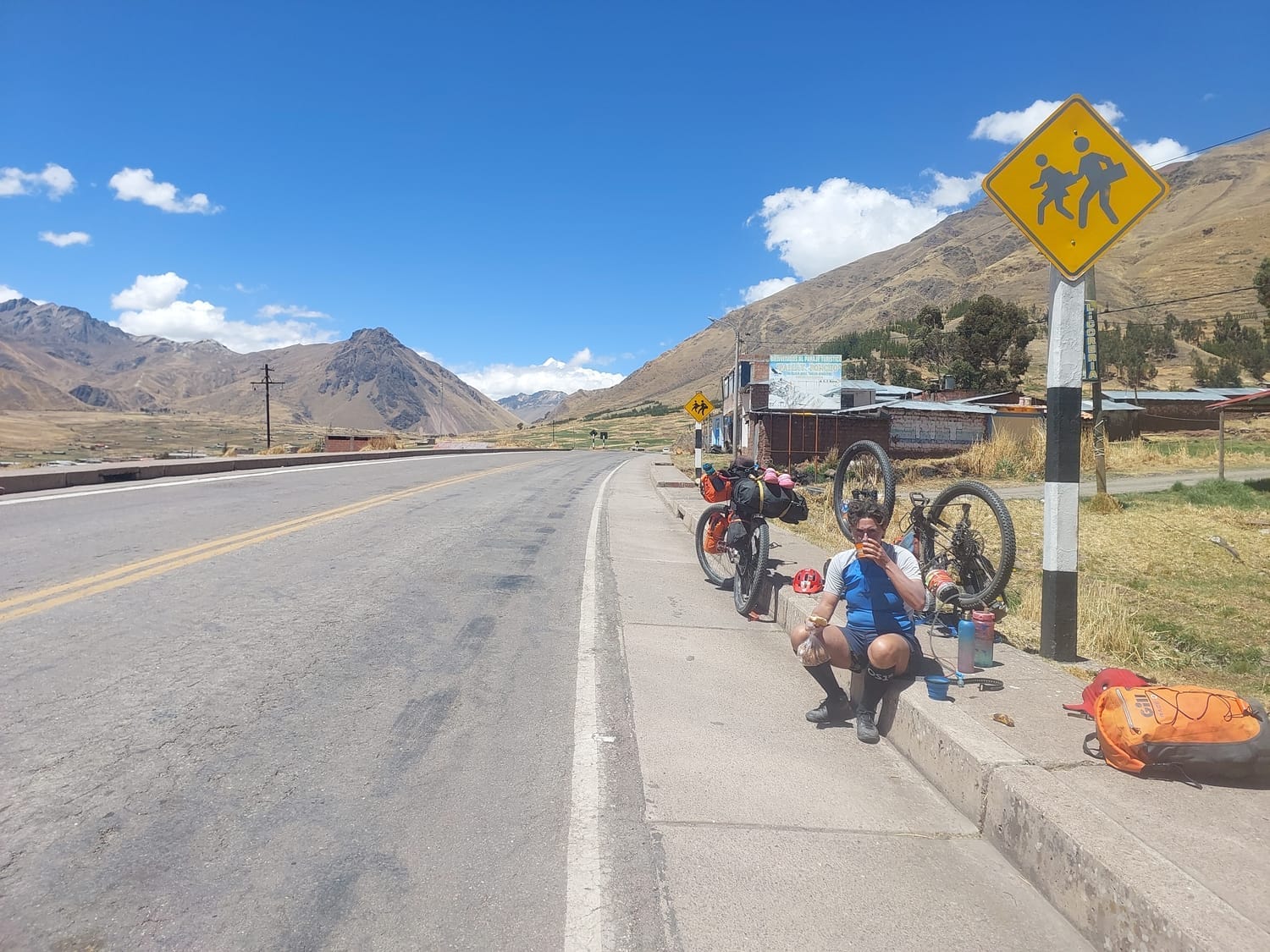
Pisac to Random River Camp
We rolled out of Pisac under a light drizzle, like the Sacred Valley itself was having a wee cry at our departure. Tears of sadness? Joy? A mix of both? Hard to say, but it felt like a proper farewell.
The road tilted gently upwards, nothing too fierce, and we cruised along easier than I expected. I’d half-worried our legs might’ve gone soft after our volly time....but nah! The wheels were spinning smooth.
True to my promise to keep body and spirit in one piece, we pulled over every so often to stretch, shake out the shoulders, and just move off the saddle. No point flogging ourselves when there’s still a whole continent to ride.
By hour two we rolled into a crossroads with a tiny tendita, the kind of place where time seems to stand still. We tucked into greasy-good papa fritas, washing them down with steaming termos coffee we’d packed.
The day slid by like a lazy river, clouded skies above, pedals ticking steady beneath us. Around 3pm we spotted a sneaky track peeling off the road down toward the water. Curiosity always wins, so down we went, weaving through brush until a riverside nook opened up. It looked perfect. Out came the camping routine like clockwork: bike clothes swapped for night gear, billy on for tea, everything falling into place.
And then Maree clocked an abuela wandering nearby with her cows. Keen to do the right thing, she went over for a yarn. A quick shake of the head later...rejection! No tenting here, gracias very much.
So, tea back in the bag, bike gear back on, and we were off again, nomads on the hunt for round two. Ten minutes down the road, salvation: another little riverside hideaway, this one blissfully free of cows, caretakers, or disapproving eyes. Out came the tea kit again, layers swapped once more, and just like that, we were home.
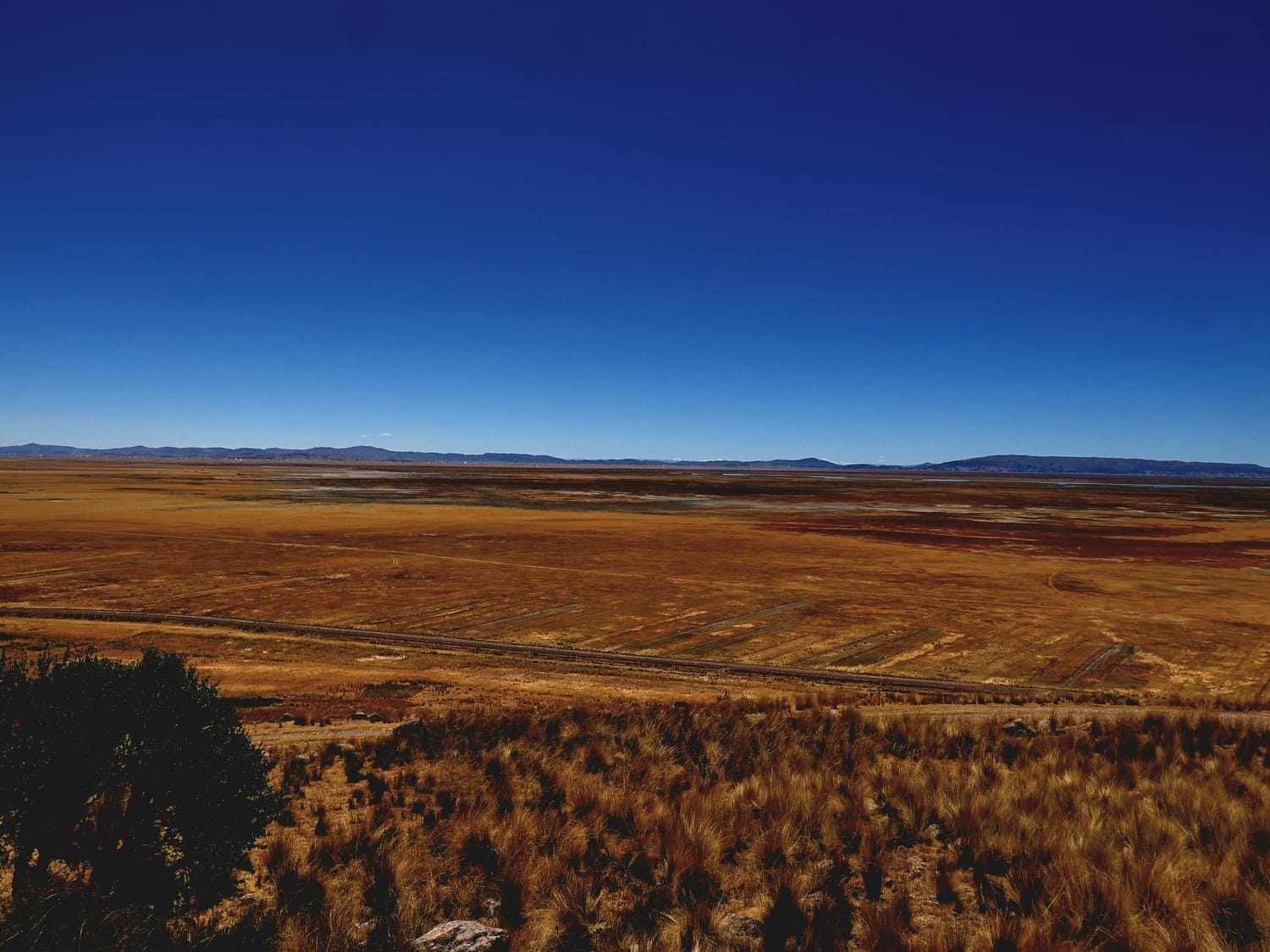
Rrandom River Camp to 1800s England!
We were off and racing early this morning. Not intentionally, we still had our usual lazy coffee in bed, breakie with more coffee, but somehow the stars aligned and we were just on the ball.
I’d put in a request for a protein-packed lunch stop, so I was quietly hoping a roadside cart or little comedor would appear like magic. Fuel is life. And as it happened my dream came true.
The day’s “mild hill” turned out to be more of an undulating rollercoaster, but nothing that had us groaning into our handlebars. And bit by bit, we pedalled away from the rugged, jagged drama of the Sacred Valley. In its place: gentler rolling hill, though, let’s be clear, still rolling along at 3,000 metres plus.
By mid-arvo we rolled into the town Situani and decided to skip the main road. Instead, we crossed to the far side of the river on a lesser road, hoping it’d deliver us a sneaky camping spot. The trade-off? Back to bumpy, dusty gravel. The kind that rattles your teeth loose.
Our theory was sound. fewer cars, more hidden corners. But reality? House after house, farm after farm. After an hour of bouncing along, with daylight fading fast, our optimism was fading with it.
Then we spotted it: a bridge. Salvation. We cut back across the river, hedged our bets, and followed a track towards some railway lines. We clattered over the rails and suddenly it was like stepping through a portal.
Before us stood a grand, derelict building, the sort of thing you’d expect in 1890s England, not high in the Peruvian hills. Beside it, a crumbling bell tower leaned like it hadn’t been rung in a hundred years. Lining the railway were old houses that looked long-abandoned, frozen in another time. It was eerie, but fascinating.
We decided this forgotten place would be home. We tucked ourselves into the back of the grand building, hidden from the road, the air still and quiet. Just us, the sound of the river in the distance and one curious dog who came to hang out for a while before buggering off at tent o’clock.
Tent time is early here, 7pm, its dark by 6. We tuck in by 7, like a pair of nana-adventurers. But hey, when your camp is an abandoned railway ghost town, it’s not a bad place to call it a night.
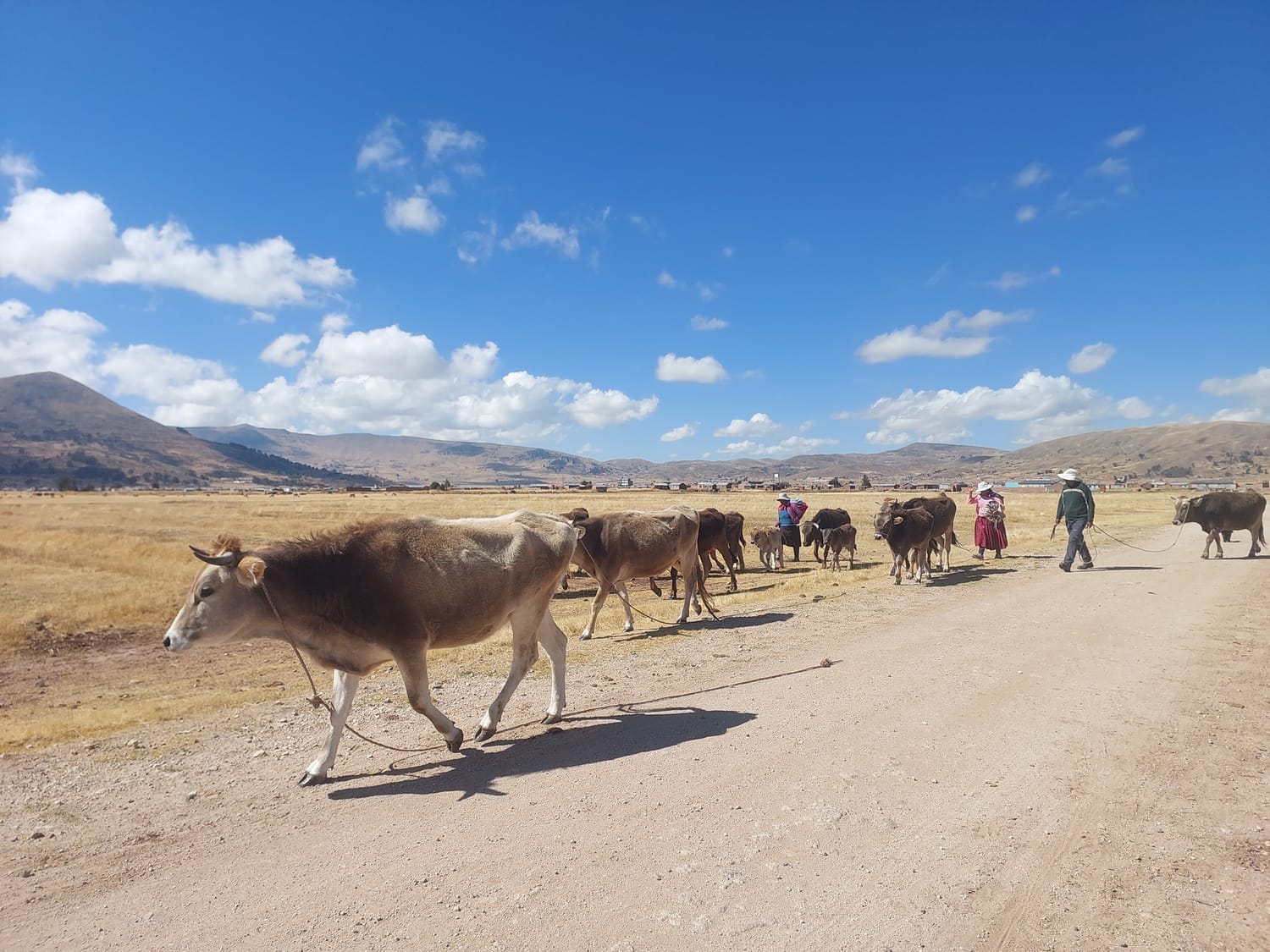
1800s England to 4330m
One of my favourite sayings is: your perception is your reality.
And if you’d asked Maree about today, her “reality” would’ve been a whole different story to mine.
We’d been grinding away at this climb for the last two days, legs ticking, lungs adjusting. Today’s task: 37 kilometres to the very top. Altitude? A spicy 4,330 metres — the highest we’d climbed yet on this whole madcap adventure.
Maree caught the altitudes early. Not a case of harden-up concrete pills, but an actual pill for altitude. Didn’t seem to matter much — she was in struggle city before morning tea. At first she said it was just fatigue, though she was still moving alright. Then her bike clearly felt sorry for her and decided to force a break — front brakes jamming so tight we had to pull over for a roadside tinker.
Seeing she was in the hurt box, I dialled my pace right back and rode with her. I even chucked on some music to lighten things up. In my head, I was giving a Grammy-worthy performance. According to Maree? My out-of-tune wheeze-singing was more punishment than help. And the fact I could belt out a tune while pedalling — when she was gasping for air — just about tipped her over the edge.
By mid-arvo it turned into a survival game of road sign to road sign. Each one was a mini finish line, though sometimes they were 50 metres apart, other times a good few hundred. You never knew if you’d won the sprint or signed up for another marathon.
But the top? Pure gold. Suddenly we were gliding through a glaciated valley, jagged cliffs rising around us, glaciers gleaming in the background. Spectacular doesn’t even cover it. And then the cherry on top — the downhill. Maree could finally sit back, breathe, and let gravity do the mahi.
Camp hunt time. A sign appeared: Lodge & Camping. Jackpot, we thought. Up we rolled, greeted by a welcoming committee of three friendly dogs, three sheep, and three alpacas — all tails, bleats, and hums. Then came the human. “Camping? Sí… 100 soles.” Pardon? Yep. One. Hundred. Soles. For a patch of grass. “See ya later, señorita.”
Back down the road we trundled, daylight fading. And then, tucked away, an old market site, roofed and quiet, sitting pretty above the road. Flat ground, shelter, and no price tag attached. Perfect.
For Maree, it had been a slog of a day — lungs burning, every kilometre hard-earned. For me? A breezy cruise through the mountains, music and all. Same road. Same distance. Totally different realities.
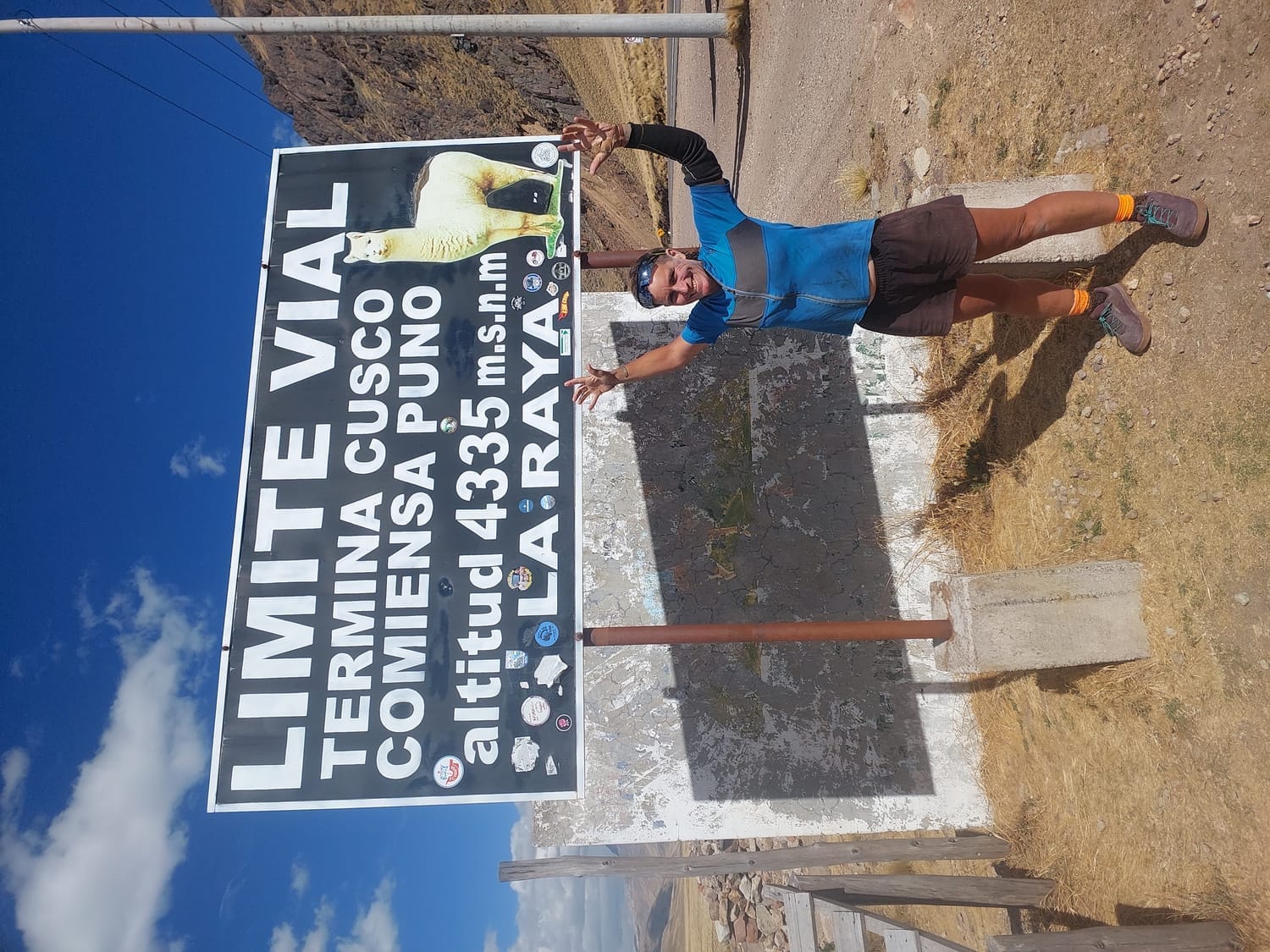
4330m to Pucara
We woke in our wee market sanctuary, tucked away like smug little bandits. From our hiding spot we could see everything — the valley, the river, the world waking up — but no one could see us. Perfect.
Up-valley, where we’d pedalled from yesterday, a wall of rain hung heavy, sulking in the distance. The air was brisker than days past, a nippy reminder that we were climbing higher into the Andes. For once, shorts and a merino tee weren’t going to cut it. I pulled on thermal legs and even a rain jacket, while Maree rugged up beside me. As we packed, I noticed the rain wall had crept closer, marching steadily our way.
Sure enough, as we rolled down the valley, the chase was on. The odd drop of rain smacked our arms like a warning shot: you can’t outrun me forever.
We were gliding across a vast alpine plateau, hemmed in by rolling hills that framed the horizon like soft brushstrokes. Ahead loomed serrated mountain ranges, jagged and unapologetic. The land was alive with tiny farmsteads, sheep, cows, and the occasional nonchalant herd of alpaca. With the sky streaked in cumulus clouds and a grey haze, it felt like we were pedalling through a living canvas — and we were the accidental brushstrokes.
After yesterday’s uphill grind, the hunger hit me early. About two hours in we stumbled upon a cheese factory shop. Morning tea: papa fritas and an ice cream. Fuel of champions. I held back though, saving room for the proper big lunch I knew would come in the next town. Spoiler alert: it didn’t.
Ayaviri, a decent-sized town, greeted us with a bustling market where we stocked up on basics. But heartbreak — no food court. No sizzling chicharrón, no smoky lomo saltado. My dreams of protein glory were dashed. We hunted instead and found a pollo joint off the main square. Plates of roast chicken finally arrived after what felt like a geological age. Only problem: the chicken was still clucking. Half-raw. I had Lima trauma flashbacks.
We tried again, sending it back to be “cooked properly.” It came back looking slightly less alive. We pushed it around our plates, our stomachs groaning. The most disappointing meal of the entire trip, hands down. We rolled out of town feeling robbed.
And as if on cue, the rain wall caught us. This time it brought mates: thunder and lightning. We layered up — gloves, thermals, rain jackets, the lot — and cycled back into the high plateau, raindrops stinging our faces. To be honest, I’d half expected the Andes to be like this all along: grey, freezing, hypothermic slogs. But no — most days we’d been raisins, shrivelling under the blazing sun. So this wild weather felt almost exhilarating.
A few soggy hours later, eyes peeled for any hint of a sneaky camp, we rolled into a small town.
“Babe!” Maree called from behind me. That tone. I knew it instantly. She’d spotted a hostal. Translation: today’s ride was over. No arguments from me.
Our “top notch” hostal turned out to be classic Andean chic: a rickety bed, no running water, one window completely missing (natural air-con), and a generous pile of scratchy warm blankets. But outside the rain battered the rooftops while we were dry, snug, and laughing about our near-miss with salmonella. Can’t complain.
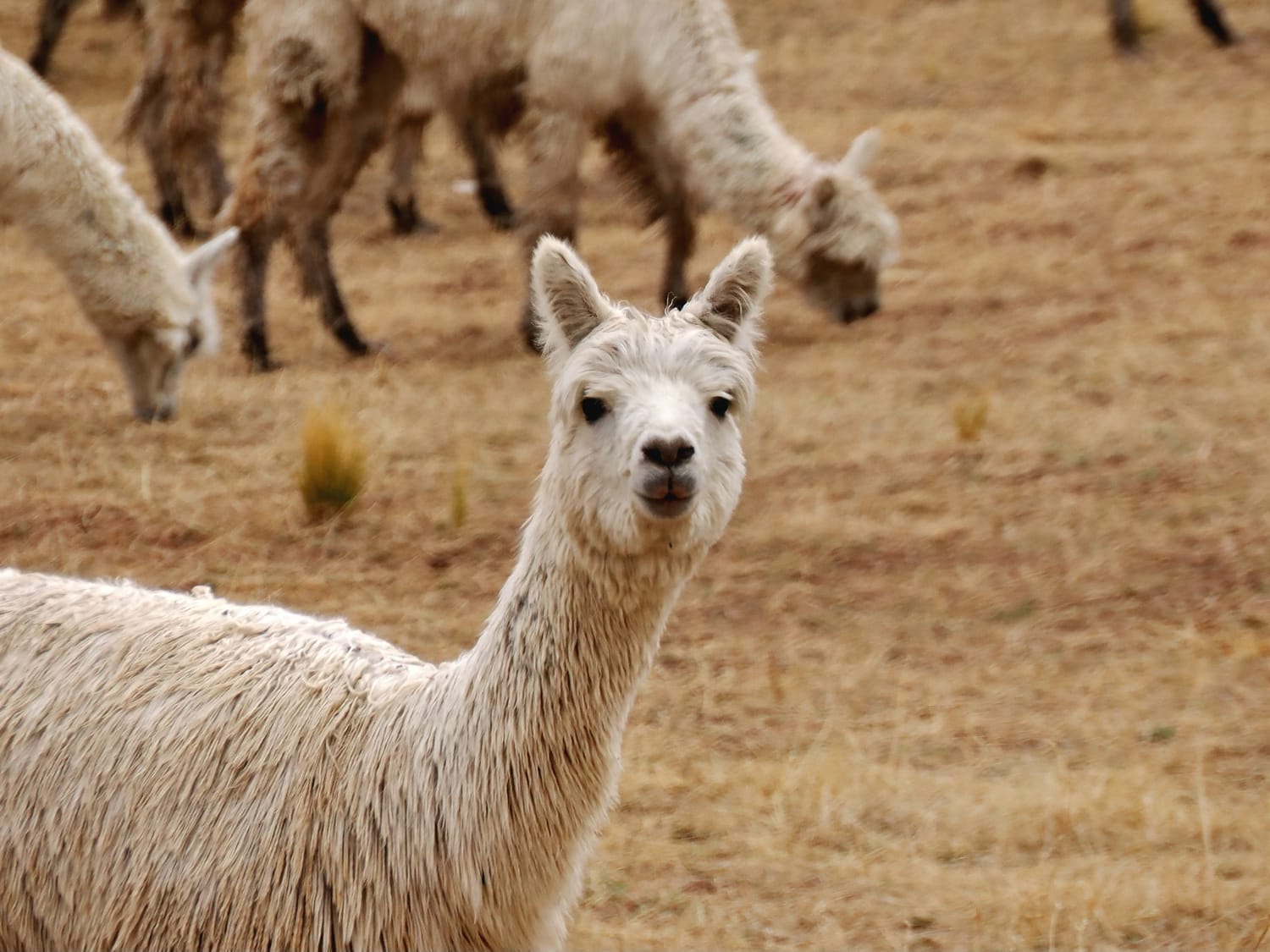
Pucara to Juliaca
It was colder in our shack of a hostal room than in the tent this morning. A concrete fridge with a rickety bed and a missing window. Who needs air-con when you’ve got a gale blowing through the room?
Still, we managed to cook up our trusty breakie and brew coffee before hitting the road, hands wrapped round mugs like life rafts.
Pedalling out onto the plateau, I had déjà vu. In my early twenties I’d hitched across Canada and scored a ride with a truckie over the Rockies. Cycling through this vast alpine plain felt exactly like that: endless skies, horizon stretching forever, the land rolling in a slow, hypnotic rhythm.
Another memory popped up too, a cross-country mountain bike trip a few years back with mates in the Lindis, NZ. In the late afternoon we were seeking the pass to drop us back to the main road. Every dip in the hillside we’d say, “Yip, that’s it!” only for the track to veer off in another direction. That’s exactly what today was like, only bigger. And longer. And higher.
But what a buzz. Slight downhill, a cheeky tailwind, and I was flying. Maree, still in recovery mode from her altitude-downer day, spun along steadily beside me while I was away laughing.
Then came the jackpot. A tiny roadside store with a sign: Kankacho. Maree ducked to the loo while I poked my nose in. The lady lifted a lid to reveal roast lamb and spuds. Heaven.
“Sí, por favor!” I ordered a plate, grinning like a kid at Christmas. By the time Maree came back, I was halfway through, grease on my fingers, pure joy on my face. She didn’t need convincing to join in.
Fueled on lamb and potatoes, we pushed on to Juliaca, a shock to the system after days of calm. Absolute sensory overload. Horns blaring, trucks belching, people shouting, dogs weaving between it all. Chaos at full volume. After weeks of valleys and quiet villages, it was like being thrown into a blender.
Maree was cooked, running on fumes. I couldn’t face stopping right in the thick of the madness, so we threaded through town, dodging tuk-tuks and taxis, until we hit the outskirts. There, salvation: a cheap hotel, nothing flash, but four walls and a door that shut out the racket. Early finish, but Maree collapsed into bed and I couldn’t argue.
